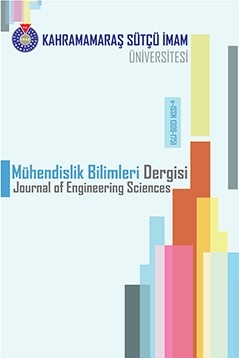Termal Olarak Sıkıştırılmış Ceviz Kaplama Levhaların Yüzey Kalitesindeki Değişimlerin Araştırılması
Termal Olarak Sıkıştırılmış Ceviz Kaplama Levhaların Yüzey Kalitesindeki Değişimlerin Araştırılması
Basınç, Yüzey kalitesi, Ceviz kaplama, Sıcaklık,
___
- Akerholm, M., and Salme´n, L. (2004). Softening of wood polymers induced by moisture studied by dynamic FTIR spectroscopy. J. Appl. Polym. Sci. 94: 2032–2040.Stamm, A.J. 1964. Wood and cellulose science. New York (USA): Ronald Press;
- Aydın, I, Colakoglu G. (2002). The effects of veneer drying temperature on wettability, surface roughness and some properties of plywood. In: Proceedings of the sixth panel products symposium, 9–11 October, Llandudno, Wales, UK. p. 60–70.
- Ayrilmis, N., Winandy J.E. (2009). Effects of post heat-treatment on surface characteristics and adhesive bonding performance of medium density fiberboard. Mater Manuf Process, 24, 594–599.
- Bekhta, P., Hiziroglu, S., Shepelyuk O. (2009). Properties of plywood manufactured from compressed veneer as building material. Mater Des; 30(4):947–53.
- Bekhta, P., Niemz, P., Sedliacik, J. (2012). Effect of pre-pressing of veneer on the glueability and properties of veneer-based products. Eur. J. Wood Prod. 70:99–106
- Boonstra, M.J., Blomberg, J. (2007). Semi-isostatic densification of heattreated radiata pine. Wood Sci Technol 41(7):607–617Seborg,
- Candan, Z., Hiziroglu, S., McDonald, A. G. (2010). Surface quality of thermally compressed Douglas fir veneer. Materials & Design, 31(7), 3574-3577.
- Dündar, T., As, N., Korkut, S., Unsal, Ö., (2008). The effect of boiling time on the surface roughness of rotary-cut veneers from oriental walnut (Fagus orientalis L.). J. Mater. Process. Tech., 199, 119-123.
- Faust, T.D., Rice, J.T. (1986). Effect of veneer surface roughness on glue-bond quality in Southern pine plywood. Forest Prod J; 36(4):57–62.
- Follrich, J., Muller, U., Gindl, W. (2006). Effects of thermal modification on the adhesion between spruce. wood (Picea abies Karst.) and a thermoplastic polymer, Holz Roh-Werkst, 64, 373–376.
- International Standard ISO 4287, (1997). Geometrical product specifications (GPS) – surface texture: profile method—terms, definitions, and surface texture parameters. International Organization for Standardization, Geneva, Switzerland.
- Kutnar, A., Kamke, F. A., and Sernek, M. (2009). Density profile and morphology of viscoelastic thermal compressed wood. Wood Sci. Technol. 43: 57–68.
- Kantay, R., Unsal, O., Korkut, S. (2003). Investigations of surface roughness of sliced Walnut and Beech veneers produced in Turkey. Rev Forest Faculty, Univ Istanbul Ser A; 51(1):15–31.
- Lebow, P.K., Winandy, J.E. (1998). The role of grade and thickness in the degradation of fire retardant-treated plywood. Forest Prod J; 48(6):88–94.
- Norimoto, M. (1993). Large compressive deformation in wood. Mokuzai Gakkaishi 39(8):867–74.
- Taylor, J.B., Carrano, A.L., Lemaster, R.L. (1999). Quantification of process parameters in a wood sanding operation. Forest Prod J; 49(5):41–6.
- Unsal, O., Candan, Z. (2008). Moisture content, vertical density profile and janka hardness of thermally compressed pine wood panels as a function of press pressure and temperature. Dry Technol. 26(9):1165–9.
- Wolcott, M. P., Kamke, F. A., and Dillard, D. A. (1990). Fundamentals of flakeboard manufacture: viscoelastic behavior of the wood component. Wood Fiber Sci. 22: 345–361.
- Yıldız, S. (2002). Physical, mechanical, technological, and chemical properties of Fagus orientalis and Picea orientalis wood treated by heating. PhD thesis, Blacksea Technical University, Trabzon, Turkey, p 245.
- Başlangıç: 1998
- Yayıncı: Kahramanmaraş Sütçü İmam Üniversitesi
Termal Olarak Sıkıştırılmış Ceviz Kaplama Levhaların Yüzey Kalitesindeki Değişimlerin Araştırılması
Ferhat ÖZDEMİR, Ertuğrul ALTUNTAŞ, Ayşegül ÇOT, Ahmet TUTUŞ
Development of Flexible Smart Fabric Sensor for Wearable Electrocardiogram
Suat ÇETİNER, Beytullah GÖL, Hidayet KÖSE
Fotovoltaik Üretim Sistemlerinin Şebekeye ve Maliyetlere Etkisinin İncelenmesi
Zeynel BAŞ, Serhat ZIBA, Ahmet Serdar YILMAZ
Kahramanmaraş Havalimanı İçin Uçaklardan Kaynaklanan Emisyonların Belirlenmesi
Nihan BABAOĞLU, Kıymet ÖZGÜNOĞLU
Tekstil Atıksularının Membran Filtrasyon Yöntemleri İle Geri Kazanımı
Mehmet Nurullah GERGİN, Yakup CUCİ
Atık Malzemelerin Kendiliğinden Yerleşen Beton Performansına Etkisi
Sevgi DEMİREL, Hatice Öznur ÖZ
Yüksek Sünek Merkezi Çaprazlı Çelik Çerçevelerin Yatay Yükler Altında Davranışının İncelenmesi
Uzaktan Kontrol Edilebilen Mobil Robota Bağlı İşaretleyici İle Hedef Takibi
Beton Basınç ve Eğilme Dayanımlarına CFRP’nin Etkisi
Turgut KAYA, Murat ARAS, Özlem ÇALIŞKAN
